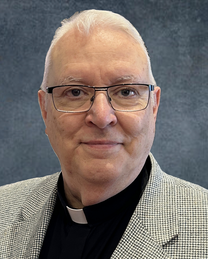
The Reverend Lewis D. Crusoe is the Priest-in-Charge at St James. His theological training was at Sacred Heart Seminary in Detroit and St. John's Provincial Seminary in Plymouth, Michigan. Both were Roman Catholic seminaries. Rev. Crusoe joined the Episcopal Church in April of 2010 and was ordained an Episcopal priest on January 23, 2016 by the Rt. Rev. S. Todd Ousley bishop of the Episcopal Diocese of Eastern Michigan.
Fr. Crusoe also holds a Master's Degree in Professional Accountancy (M.S.P.A.) from Walsh College in Troy, Michigan, and is an IRS Enrolled Agent (E.A.) licensed to practice before the Internal Revenue Service. He practices individual income tax preparation in addition to his duties at St. James.
So what is the difference between a Rector and a Priest-in-Charge?
When there is pastoral vacancy in an Episcopal Church, the Vestry or governing body of laypersons interview prospective candidates for the position of Rector or Pastor. When they arrive at their final selection they submit the name to the Bishop of the Diocese who then confirms the call of the Vestry and that person becomes the Rector. The Rector usually remains in the position until he or she retires or accepts a call from another parish.
An alternate method of filling the pastoral vacancy is to contact the Bishop and ask if he or she knows of priest that might be available for part-time ministry. The bishop will then send candidates to the Vestry for interviews. If the Vestry chooses one of the candidates, the Bishop appoints the priest as a Priest-in-Charge. Since the Bishop appoints the priest to the parish, the Bishop can also recall the priest and assign him or her to another parish which needs a priest.
In the case of a Rector then, the Vestry calls and the Bishop confirms the call.
In the case of a Priest-in-Charge, the Bishop appoints and the Vestry accepts the appointment.
Since Fr. Crusoe was already a lay member of St. James, the process was quite natural as he was raised up from among the congregation to lead the parish.
The Reverend Lewis D. Crusoe is the Priest-in-Charge at St James. His theological training was at Sacred Heart Seminary in Detroit and St. John's Provincial Seminary in Plymouth, Michigan. Both were Roman Catholic seminaries. Rev. Crusoe joined the Episcopal Church in April of 2010 and was ordained an Episcopal priest on January 23, 2016 by the Rt. Rev. S. Todd Ousley bishop of the Episcopal Diocese of Eastern Michigan.
Fr. Crusoe also holds a Master's Degree in Professional Accountancy (M.S.P.A.) from Walsh College in Troy, Michigan, and is an IRS Enrolled Agent (E.A.) licensed to practice before the Internal Revenue Service. He practices individual income tax preparation in addition to his duties at St. James.
So what is the difference between a Rector and a Priest-in-Charge?
When there is pastoral vacancy in an Episcopal Church, the Vestry or governing body of laypersons interview prospective candidates for the position of Rector or Pastor. When they arrive at their final selection they submit the name to the Bishop of the Diocese who then confirms the call of the Vestry and that person becomes the Rector. The Rector usually remains in the position until he or she retires or accepts a call from another parish.
An alternate method of filling the pastoral vacancy is to contact the Bishop and ask if he or she knows of priest that might be available for part-time ministry. The bishop will then send candidates to the Vestry for interviews. If the Vestry chooses one of the candidates, the Bishop appoints the priest as a Priest-in-Charge. Since the Bishop appoints the priest to the parish, the Bishop can also recall the priest and assign him or her to another parish which needs a priest.
In the case of a Rector then, the Vestry calls and the Bishop confirms the call.
In the case of a Priest-in-Charge, the Bishop appoints and the Vestry accepts the appointment.
Since Fr. Crusoe was already a lay member of St. James, the process was quite natural as he was raised up from among the congregation to lead the parish.





